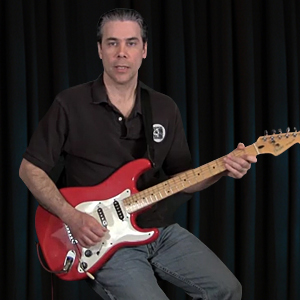Practicing Major Triads & Inversions Series 3
Description
This time we start with the root position A major chord. The closest possible D major chord is a second inversion chord. Again it has a common tone A, and the other two notes of the chord move minimally; one note moves up a half-step and another moves up a whole-step. Pitchwise, from low to high, we get:
A to A - same pitch
C# to D - up half-step (1 fret)
E to F# - up whole-step (2 frets)
We move back to the A major chord. Next we look for the closest possible E major chord. This happens to be the first inversion shape E major below the A major. Again, the note E is a common tone. The other two notes of the chord move minimally. One note moves down a whole-step and another moves down a half-step. Pitchwise, from low to high, we get:
A to G# - down half-step (1 fret)
C# to B - down whole-step (2 frets)
E to E - same pitch
Notice a very important pattern emerges concerning a I-IV-I-V chord progression. In this case A(I)-D(IV)-A(I)-E(V).
The distance from any given I chord to it's closest voicing IV chord always involves three characteristics:
Root note of I chord to 5th of IV chord - same pitch
3rd of I chord to root note of IV chord - up half-step (1 fret)
5th of I chord to 3rd of IV chord - up whole-step (2 frets)
Depending upon which voicing you start with, these motions could be in a different order, but all three will always be present in some order. Likewise, the distance from any given I chord to it's closest voicing V
chord always involves three characteristics:
Root note of I chord to 3rd of V chord - down half-step (1 fret)
3rd of I chord to 5th of V chord - down whole-step (2 frets)
5th of I chord to root note of V chord -same pitch
Again, depending upon which voicing you start with, these motions could be in a different order, but all three will always be present in some order.
This is a very important feature of all I-IV-I-V chord progressions with incredibly wide ranging implications, applications and potential.
Lesson Info
Tutorial Lessons
- Introduction
- Root Position Triads
- Root Position Triads With A Backing Track
- First Inversion Triads
- First Inversion Triads With A Backing Track
- Second Inversion Triads
- Second Inversion Triads With A Backing Track
- Close Harmony Voice Motion
- Close Harmony Version 1 With A Backing Track
- Close Harmony Version 2
- Close Harmony Version 2 With A Backing Track
- Close Harmony Version 3
- Close Harmony Version 3 With A Backing Track
- Using All The Voicings!
- Using All The Voicings With A Backing Track
- Conclusion
